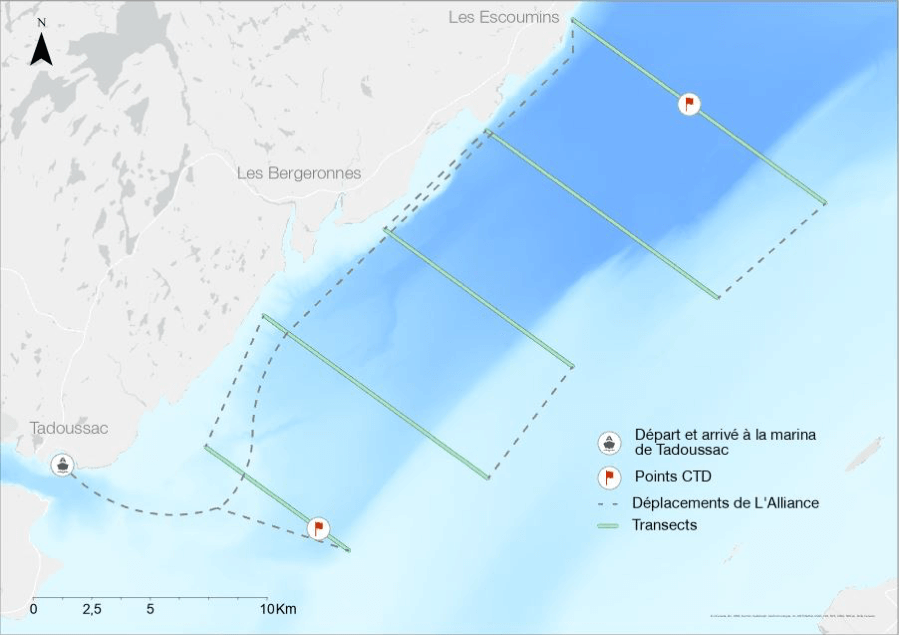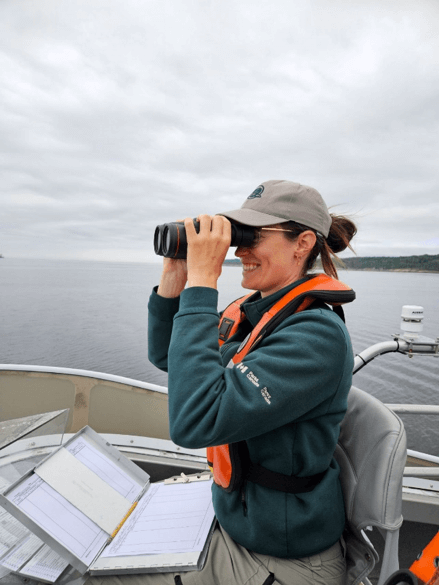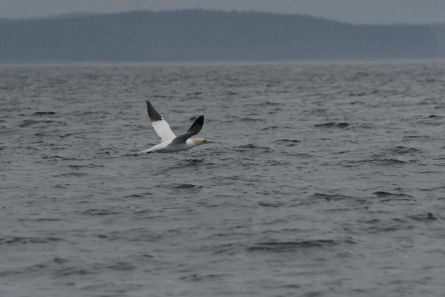Once a week during the summer season, we carry out predator-prey monitoring in the lower estuary. The objective of this project is to document the relationships between the abundance and distribution of marine mammals, seabirds and their prey in the Saguenay-St. Lawrence Marine Park. It’s 8 in the morning. Eliza, Sarah and I board the boat L’Alliance where our valiant captain Simon awaits us. As soon as we arrive, I download our transects onto the navigation computer and we head downstream.
What’s a transect?
A transect is a linear trajectory from which we collect scientific data. Our transects are arranged randomly in the Lower Estuary and run perpendicular to the coast. We carry out a total of five transects per day between the docks in Les Escoumins and the K54 buoy off the coast of Tadoussac. Each sampling day we carry out new transects. This data collection method allows us to limit any biases in our analyses.
Activating the depth sounder
Once we reach the end of our transect, we put the depth sounder in the water. The depth sounder generates sounds of different frequencies in the water column and records the echoes that bounce off targets such as fish, zooplankton, vegetation, the seabed, etc. We then use these data to classify prey types and measure the abundance and density of pelagic organisms below the water surface.
Observing predators
Once we activate the sounder, it’s time to go up to the upper deck and get ready to begin our first transect. Simon needs to follow the transect at a speed of around 6 knots in order for us to obtain quality data, both for predators and prey. As soon as the transect begins, my colleagues and I position ourselves on the deck and scan the horizon in search of predators and boats. Sarah and I are responsible for observing marine mammals and boats while Eliza concentrates exclusively on seabirds. We collect information on the presence of predators, time of observation, distance and any particular behaviours observed. The information that we collected will allow us to document inter-annual variation and predator distribution as well as the relationship between predator and prey abundance and distribution.
Physical and chemical data
After 30 minutes of observation, our captain Simon informs us that we have reached the CTD (Translator’s note: conductivity, temperature and depth) point. The team suspends its observations and deploys the sonde to measure temperature, salinity, oxygen and fluorescence from the surface to the seabed.
Four transects and one CTD point later and our field work is complete. Our day in the field is over, but our work doesn’t end there! A great deal of data has been collected, but we will still have to compile and analyze them.
A look at some of our summer observations
July 12: Several sightings of juvenile common murres with their parents.
July 31: Swarm of krill around 100 m deep over the northern cliff near the Natakam Condos in Essipit and the outdoor recreation area in Les Bergeronnes. There we spot a number of boats observing humpbacks.
August 10, 2023: The weather conditions are excellent and we observe several porpoises, including near the southern cliff in the Lower Estuary, where there are also small schools of fish.
August 15, 2023: Observation of around twenty sub-adult northern gannets. Opposite the Moulin à Baude sector in Tadoussac, we observe a few schools of fish. Moving south, as soon as the water depth reaches 100 metres, we spot a dense school of krill on the echogram. We even have to halt our transect when a humpback whale surfaces just 200 metres in front of us.
In conclusion, the big star this summer is krill! We observed dense congregations on just about all of our trips out to sea. It is difficult to predict what next year will bring due to the complexity of the factors that influence prey abundance in the Marine Park. Documenting what happens both on the water surface and in the depths is essential to better understanding and protecting the ecosystems of the St. Lawrence Estuary!










